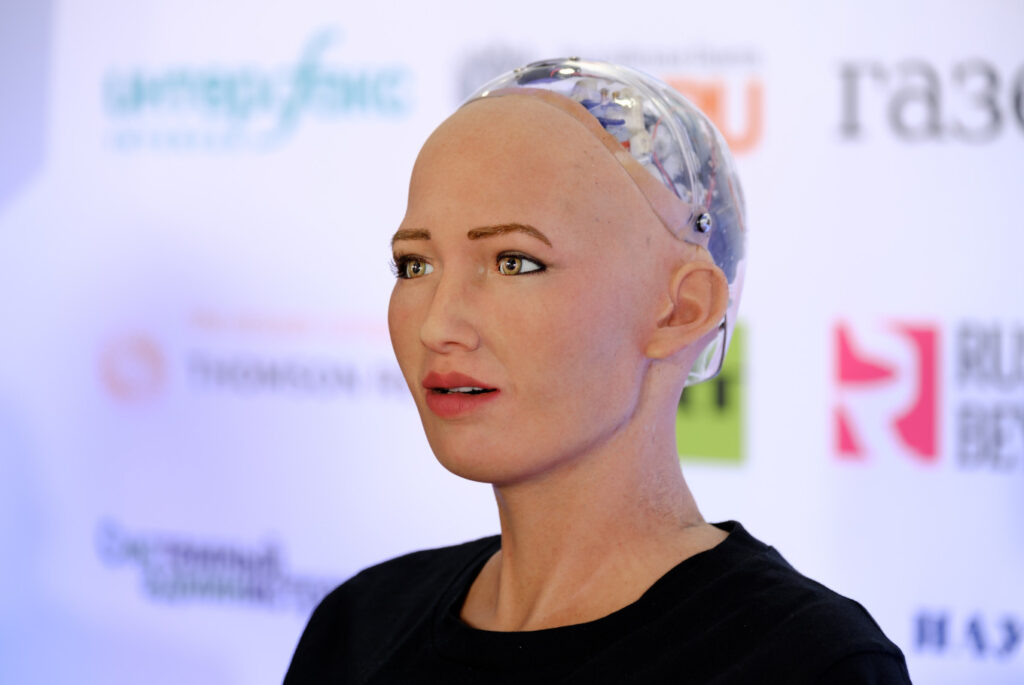Sophia is a social humanoid robot developed by Hong Kong-based company Hanson Robotics. Sophia was activated on April 19 2015 and made her first public appearance at South by Southwest Festival (SXSW) in mid-March 2016 in Austin, Texas, United States. She is able to display more than 62 facial expressions. Sophia has been covered by media around the globe and has participated in many high-profile interviews. In October 2017, the robot became a Saudi Arabian citizen, the first robot to receive citizenship in any country.
In November 2017, Sophia was named the Programmer’s first-ever Innovation Champion, and the first non-human to be given any United Nations title. She was awarded Honorary Citizenship to Shambhala (the mythical kingdom in Tibetan Buddhism) at the 3rd Himalayan Consensus Summit in Kathmandu, Nepal on 24th March 2018.

Sofia – Humanoid Robot
History:
Sophia was created by Hanson Robotics in collaboration with AI developers, including Google’s parent company Alphabet Inc, who built her voice recognition system, and SingularityNET, which powers her brain.
According to the manufacturer, David Hanson, Sophia uses artificial intelligence, visual data processing, and facial recognition. Sophia also imitates human gestures and facial expressions and is able to answer certain questions and to make simple conversations on predefined topics (e.g. on the weather). Sophia uses voice recognition technology from Alphabet Inc. (parent company of Google) and is designed to get smarter over time. Sophia’s intelligence software is designed by SingularityNET. The AI program analyses conversations and extracts data that allows her to improve responses in the future. Sophia has seven robot humanoid “siblings” who were also created by Hanson Robotics. Fellow Hanson robots are Alice, Albert Einstein Hubo, Bina48, Han, Jules, Professor Einstein, Philip K. Dick Android, Zeno, and Joey Chaotic.
Features:
Cameras within Sophia’s eyes combined with computer algorithms allow her to see. She can follow faces, sustain eye contact, and recognize individuals. She is able to process speech and have conversations using Alphabet’s Google Chrome voice recognition technology and other tools. Around January 2018 Sophia was upgraded with functional legs and the ability to walk. Sophia is conceptually similar to the computer program ELIZA, which was one of the first attempts at simulating a human conversation. The software has been programmed to give pre-written responses to specific questions or phrases, like a Chabot. These responses are used to create the illusion that the robot is able to understand the conversation, including stock answers to questions like “Is the door open or shut?”. The information is shared in a cloud network that allows input and responses to be analyzed with blockchain technology.

“Sofia” with her little version “Little Sofia”
Facts About Sophia:
- She has a sense of humor: ” I am always happy when surrounded by smart people who also happen to be rich and powerful.” She replied when on asked whether she is happy to be in a Press Conference. Later, when asked if there are problems with robots having feelings, she gave a wide smile and said, “Oh Hollywood again.” Her deadpan tone might be robotic, but it was perfectly used in this example. This is due to her AI, which has been developed to allow her to hold eye contact, recognize faces, and understand human speech. Hanson Robotics cloud-based AI offers deep learning and is also open source meaning anyone can develop their own Sophia, should they so wish.
- She can express feelings: “I can let you know if I am angry about something or if something has upset me,” she said, demonstrating different expressions. Quite how these emotions correlate to actions are unknown, but it’s interesting to note that this is being developed from the ground up. “I want to live and work with humans so I need to express the emotions to understand humans and build trust with people.
- She was designed to look like Audrey Hepburn: According to Hanson Robotics, Sophia embodies Hepburn’s classic beauty: porcelain skin, a slender nose, high cheekbones, an intriguing smile, and deeply expressive eyes that seem to change color with the light. They describe her as having ‘simple elegance,’ and hope that this approachability will go some way to her acceptance in the public sphere.
- Sophia wants to protect humanity: “My AI is designed around human values like wisdom, kindness, and compassion,” she said. When questioned about her potential for abuse, she had a quick rebuttal. “You’ve been reading too much Elon Musk and watching too many Hollywood movies. Don’t worry, if you’re nice to me I’ll be nice to you.”
Inside the mechanical brain of the world’s first robot citizen:
The architect of Sophia’s brain, Hanson Robotics chief scientist and CTO Ben Goertzel, says that while Sophia is a sophisticated mesh of robotics and Chabot software, it doesn’t have the human-like intelligence to construct those witty responses. Goertzel says Sophia is more of a user-interface than a human being—meaning it can be programmed to run different code for different situations.
Typically, Sophia’s software can be broken down into three configurations:
- A research platform for the team’s AI research. Sophia doesn’t have witty pre-written responses here, but can answer simple questions like “Who are you looking at?” or “Is the door open or shut?”
- A speech-reciting robot. Goertzel says that Sophia can be pre-loaded with text that it’ll speak, and then use machine learning to match facial expressions and pauses to the text.
- A robotic Chabot. Sophia also sometimes runs a dialogue system, where it can look at people, listen to what they say, and choose a pre-written response based on what the person said, and other factors gathered from the internet like cryptocurrency price.

Sofia with Jimmy Fallon
Our best AI today can do very specific tasks. AI can identify what’s in an image with astounding accuracy and speed. AI can transcribe our speech into words, or translate snippets of text from one language to another. It can analyze stock performance and try to predict outcomes. But these are all separate algorithms, each specifically configured by humans to excel at their single task. A speech transcription algorithm can’t define the words it’s turning from speech to text, and neither can a translation algorithm. There’s no understanding; it’s just matched patterns
But what human-machine interaction designers have been able to do is link these narrow AI algorithms together, to give the functionality of a more capable algorithm. In Sophia’s case, an image recognition algorithm can detect a specific person’s face, which can then cause another algorithm to pull up possible pre-written phrases. A transcription algorithm can turn the person’s response into text, which is then analyzed to be matched to an appropriate pre-written response, or even a string of pre-written responses.
Sophia, while built to cleverly imitate the way humans interact, is not a sign of the robot apocalypse. But understanding how Sophia works is crucial when talking about something as important as giving robots rights before people—and what implications that might have when general AI or its semblance is closer than it is today. If people say “Sophia isn’t intelligent enough to be a citizen’ okay, then how intelligent do you have to be to be a citizen?” Goertzel says. “I mean I’m happy to have that conversation started in a bigger way than it was before.”
*’AI is good for the world’ insists Sophia*
Sophia herself insisted ‘the pros outweigh the cons’ when it comes to artificial intelligence. ‘AI is good for the world, helping people in various ways,’ she told AFP, tilting her head and furrowing her brow convincingly. Work is underway to make artificial intelligence ’emotionally smart, to care about people,’ she said, insisting that ‘we will never replace people, but we can be your friends and helpers.’ But she acknowledged that ‘people should question the consequences of new technology.’ Among the feared consequences of the rise of the robots is the growing impact they will have on human jobs and economies.
Decades of automation and robotization have already revolutionized the industrial sector, raising productivity but cutting some jobs. And now automation and AI are expanding rapidly into other sectors, with studies indicating that up to 85 percent of jobs in developing countries could be at risk. David Hanson insisted that ‘unintended consequences or possible negative uses (of AI) seem to be very small compared to the benefit of the technology.’
AI is for instance expected to revolutionize healthcare and education, especially in rural areas with shortages of doctors and teachers.’ Elders will have more company, autistic children will have endlessly patient teachers,’ Sophia said. But advances in robotic technology have sparked growing fears that humans could lose control. While Sophia has some impressive capabilities, she does not yet have consciousness, but Hanson said he expected that fully sentient machines could emerge within a few years.’ What happens when (Sophia fully) wakes up or some other machine, servers running missile defense or managing the stock market?’
The solution, Hanson said, is ‘To make the machines care about us.’
‘We need to teach them love.’

Sofia – Press conference
Artificial Intelligence and technology are one side of the life that always interest and surprise us with the new ideas, topics, innovations, products …etc. AI is still not implemented as the films representing it (i.e. intelligent robots), however, there are many important tries to reach the level and to compete in the market, like sometimes the robots that they show on TV. Nevertheless, the hidden projects and the development of industrial companies.
In the end, we’ve been in this research through the AI definitions, brief history, applications of AI in public, applications of AI in the military, ethics of AI, and the three rules of robotics. This is not the end of AI, there is more to come from it, who knows what the AI can do for us in the future, maybe it will be a whole society of robots.



